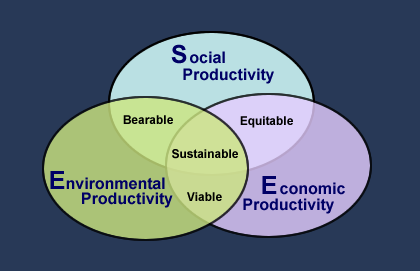National Productivity
Productivity at the national level is typically defined and measured in terms of Gross Domestic Product (GDP) per capita, per employed person or per hour worked. It is viewed by many as a key indicator of the economic health of the country. Actions that improve productivity typically enable wage gains to occur without producing inflation. Therefore, productivity so defined is essential to an economy’s ability to create real wealth.
However, in an interconnected global context, people are becoming more aware that economic growth also leads to environmental damage, depletion of natural resources, and often a widening of the societal gaps in wealth and well-being. These outcomes challenge the realized value of “productive” activity.
Ethical consumers, concerned environmentalists, global NGOs and so on are lobbying for change. Forward-looking companies are moving from concentrating on stakeholder value (how much money they make for their shareholders) to concentrating on stakeholder values, recognizing that there are multiple stakeholders whose values sometimes conflict.
Elkington (1999) coined the term ‘triple bottom line’ to represent this emerging focus on the three factors of social, environmental and economic added value. This concept has been modified over time and is now often summarised as People, Planet, Profit.
SEE productivity
More recently, these social, environmental and economic factors have been addressed by the WCPS. Several years ago, we became convinced that these three factors had to be viewed holistically and had to be viewed as a business issue, not as an ‘add-on’ issue of corporate social responsibility. At the World Productivity Congress in South Africa in 2008, the WCPS launched their concept of SEE productivity, reflecting this wider recognition that, to be sustainable in the longer-term, organisations, nations and regions need to improve all of social, environmental and economic productivities so that their operations are socially equitable, environmentally bearable AND economically viable

John Heap, President of WCPS, and Tom Burgess, a Fellow of the World Academy of Productivity Science have shown how SEE productivity could be measured at a national level. Access to the paper is given in the References section below. John, together with another colleague, Mike Dillon, Vice-President of the World Network of Productivity Organizations, have published a book “Measuring and Improving Social, Environmental & Economic Productivity: Getting It Done” which takes this concept and extends the measurement to the organisational level.
References
Elkington, J. (1999).
Triple bottom-line reporting: looking for balance.
Australian CPA, 69(2), 18-21
Heap,J. & Burgess,T. (2012)
Creating a Sustainable National Index for Social, Environmental & Economic Productivity
International Journal of Productivity & Performance Management vol 61, issue 4
